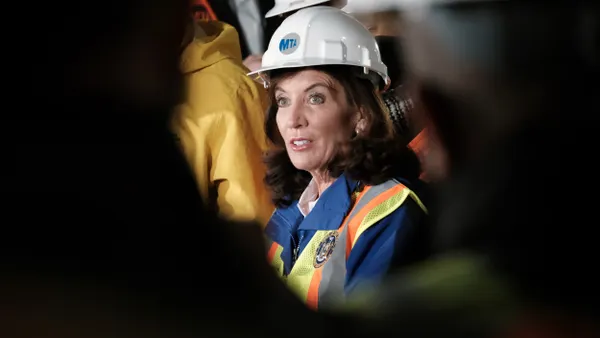Dive Brief:
- New York Gov. Andrew Cuomo's Fix NYC Advisory Panel released a report on Friday to address traffic congestion in Manhattan. Though details of a congestion pricing proposal were known on Thursday, the report breaks down various steps to implement a "phased approach" to congestion pricing.
- Phase One of the plan suggests six recommendations: identify public transportation improvements for the outer boroughs and suburbs; improve enforcement of traffic laws within the Central Business District (CBD); overhaul the NYC Placecard Program; assess and address the impact of bus congestion in the CBD; reform Taxi and Limousine Commission (TLC) regulations; and begin early work on zone pricing infrastructure regulations.
- Phase Two recommends implementing a ten-month surcharge policy for taxis and for-hire vehicles (FHV), with all revenues to be dedicated to the MTA for the Subway Action Plan. Phase Three recommends implementing the overall CBD zone pricing, first for trucks then eventually for all vehicles, once pricing zone infrastructure is "operating properly and smoothly."
Dive Insight:
Congestion pricing plans have already been implemented in big cities such as London and Singapore, and New York City will now follow suit as the first city in the U.S. with a permanent pay-to-drive plan. Gov. Cuomo praised the final congestion pricing plan, noting in a statement, "There is no doubt that we must finally address the undeniable, growing problem of traffic congestion in Manhattan's central business district and present a real, feasible plan that will pass the legislature to raise money for MTA improvements, without raising rider fares." Some transit advocates also took to the streets with signs in a peaceful protest on Sunday defend congestion pricing.
Even Mayor Bill de Blasio, who historically has opposed congestion pricing, expressed approval of the plan, stating during a radio interview that it "shows improvement over previous plans" and is a "step in the right direction."
Fix NYC's focus on FHVs was specifically touted by Cuomo, who told the New York Post that, if app-based companies such as Uber and Lyft want to "cruise through the [CBD] to pick up fares, they should have to pay for it, or we should limit the number." And it's no secret that FHVs are a major contributor to congestion. CityLab recently reported that a continued rise in the use of ride-hailing services "points to an unbated rise in congestion and emissions," and the Fix NYC report calls the impact of app-based FHVs "undeniable."
It is unlikely that the congestion pricing will immediately deter riders from utilizing app-based ride-hailing services. Many city dwellers have now been conditioned to the convenience of services like Lyft and Uber — and Fix NYC is planning to capitalize on this behavior. Assuming that loyal rideshare users continue to opt for FHVs, MTA revenues will increase and transit improvements will occur more quickly. Attitudes toward rideshare will likely shift when MTA services are more efficient, and if that shift does occur, this congestion pricing plan may be dubbed as a success.
Effects of the overall Fix NYC blueprint will occur slowly over the next few years, though if the plan is implemented properly, the blueprint could become a model plan for other U.S. cities hoping to effectively address traffic congestion.










